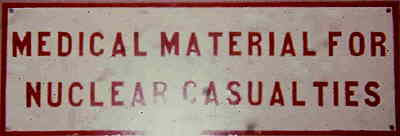Site PETER
ALASKA
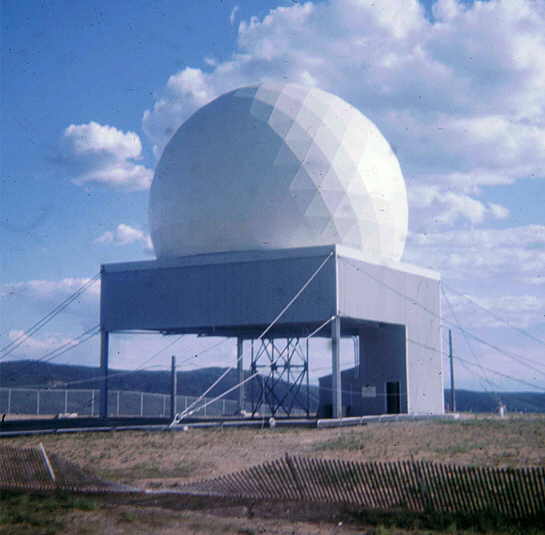
Bravo Battery
2nd Missile Battalion, 562nd Artillery



Updated 12 June, 2010




Updated 12 June, 2010
B Battery, 2nd Battalion, 562nd Artillery was one of five Nike-Hercules missile firing batteries that were deployed to provide a defensive ring of supersonic fire around the Fairbanks/Eielson AFB complex during the height of the Cold War. This webpage is an attempt to preserve some memory of the place and time that is rapidly disappearing. If you stumbled across this webpage by means other than the link from the NIKE-HERCULES ALASKA INDEX page, you may wish to go there first for a little background information before proceeding. Please CLICK HERE to do so, then follow the link back. Thank you.
Site Peter is located in the hills a few miles east of the runways of Eielson AFB and was once home to the "Bravo Banditos". This series of photographs will hopefully give a good idea of the site's geographical setting. The first two photographs below are views of the entrance to B Battey's IFC area, which served not only as the tracking and control area but as barracks, dining facility, and entertainment center for the soldiers stationed there. The photograph at the top of this page shows the dome of the site's high powered acquisition radar which was sited a couple of hundred feet up the hill from the main building seen below.
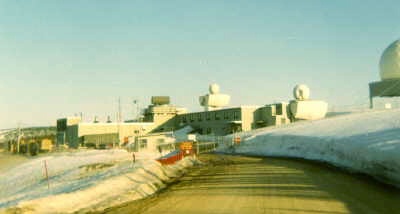
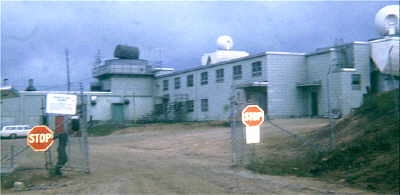
This view is from the main building showing the gate guard shack as it appeared in 1968 and the valley beyond.
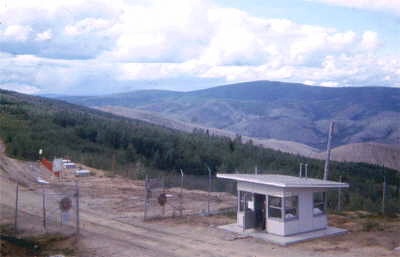
This next photo is taken from the front of the main building looking through the front gate toward the launcher area.
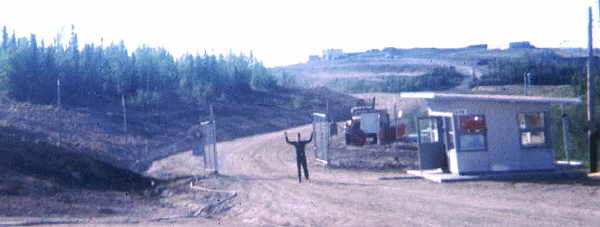
And here is a view facing the same direction as above but from the other end of the main building.
(The gate guard shack is just out of view to the right.)
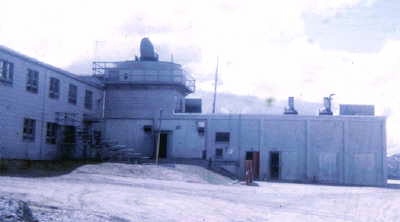
Below is yet another view from roughly the same direction (facing about northwest) but taken from the top of Baldy, a high hill nearby. If you look close you can see the launcher area beyond the IFC. This photo was taken at about 2 AM in late June under the "midnight sun" experienced at this high northern latitude.
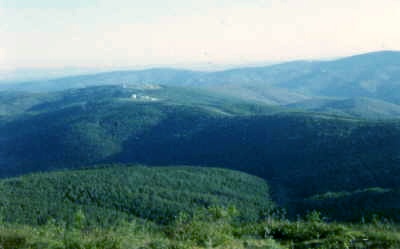
Many of the photographs shown with this article were contributed by men who were stationed at the site in 1967 and 1968, about three years before the site deactived. One notes that if facing the valley from the barracks, the helicopter landing area was to the right front.
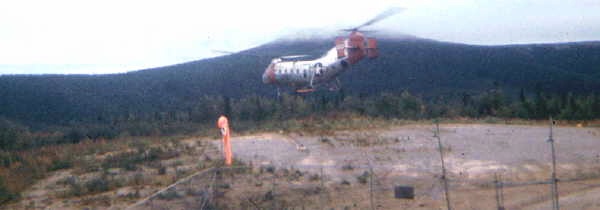
The photographer goes on to say, "If you walked in the front door, the main office was on the left. Walking down the hallway, it would open up to the rec room where the pool table was. On the left was the PX, and on the right was a small hallway that took you to the [radar and fire control] vans."
The photo at left below is of the little PX or "site exchange" where soldiers could buy beer, pop, snacks, razor blades, and other sundries. These little PX facilites were at all of the missile sites and were Godsends to the soldiers living at the sites without reliable transportation. The photo at right is of the sign as you entered the fire control area where the vans were.
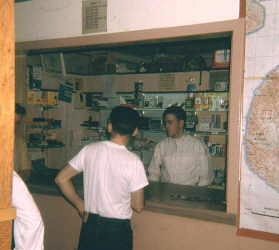
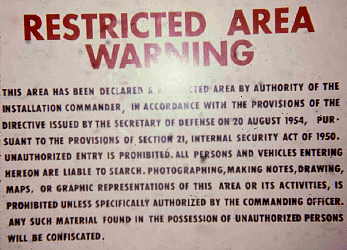
He continues: "Further on the right were the stairs that went up to the sleeping area. Beyond the stairs on the right was the TV room and straight back was the mess hall. Upstairs you first came to the rooms for Spec 5's and then the open barracks area." And, "To pass the time away, gambling was always the big thing. Especially Acey Deucey." Another contributor notes that "Besides Acey-Deucey, we could put the beer away."
All Alaskan Nike sites were continually patroled by well trained guard dogs and their MP handlers. Below is a photo of "Buddy" and his handler, circa 1967.
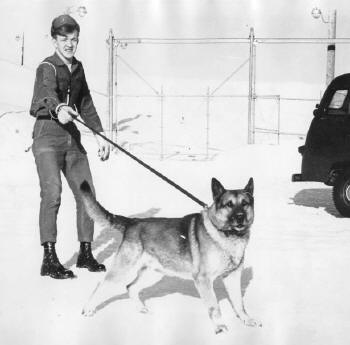
Below are a couple of photos of the oblong LOPAR (Low Powered Acquisition Radar) antenna on the top of the main building. The contributor of many of these photographs (seen in the photo at left) was an operator of this equipment.
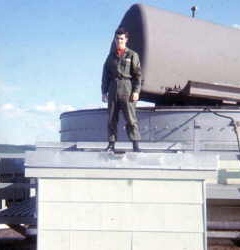
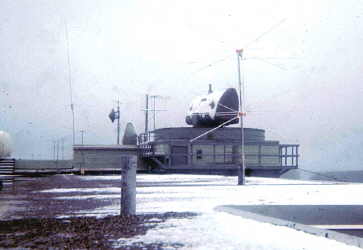
This next photo (at left below) is of the TTR (Target Tracking Radar) tower. Note the retracted steel clamshell covers that can be closed to provide shelter for maintenance during inclement weather. These covers were provided for all Alaskan Nike site tracking radars. At the right is another view along the back of the main building taken on Labor Day, September, 1967.
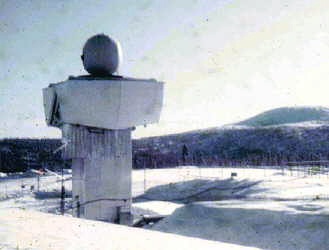
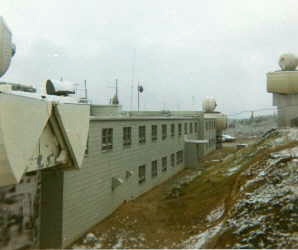
If we were to go out the front gate for a tour of the launcher area in 1967 we would see the views below. On the left is a view of the missile assembly and warhead building and on the right is a view of "Bravo section" and it's associated warhead bunker.
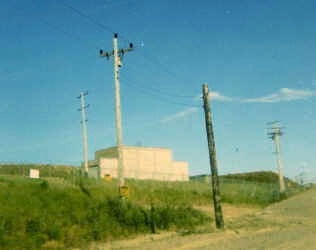
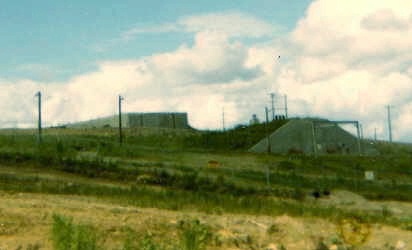
A view down the little road to the launch area's pump house:
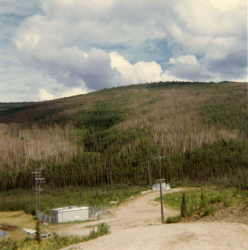
As with any military unit, continual training was an important part of gaining and maintaining proficiency with the skills and equipment needed to perform the mission. Part of this readiness training was the ASP, or Annual Service Practice, where each year every Nike-Hercules unit performed a live firing of one or more missiles to demonstrate it's readiness and be scored accordingly.
The Anchorage area's 4th Missile Battalion, 43rd Artillery's Hercules sites conducted their ASP live fire exercises from site Summit in the Chugach mountains east of Anchorage until 1964 when it was deemed unsafe due to the growing population in the area. After that time the 43rd ADA's fire units came to the Fairbanks sites to make their practice shots until the Fairbanks sites were deactivated in 1970 and 1971. After that the Anchorage batterys were required to travel to Fort Bliss, Texas to fire from the McGregor Range facility.
As you can imagine, these annual seasons of missile launches were considered quite the entertainment. Below are some newspaper clippings from "an award-winning local paper":

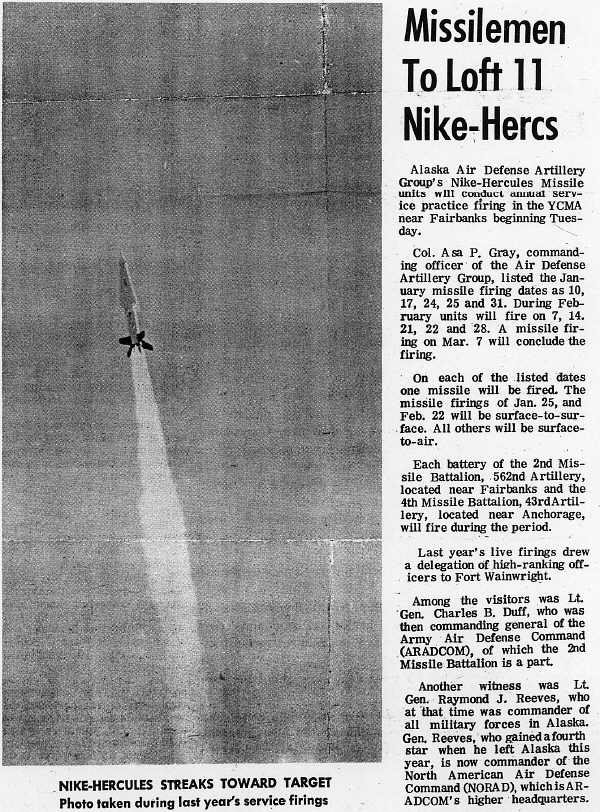
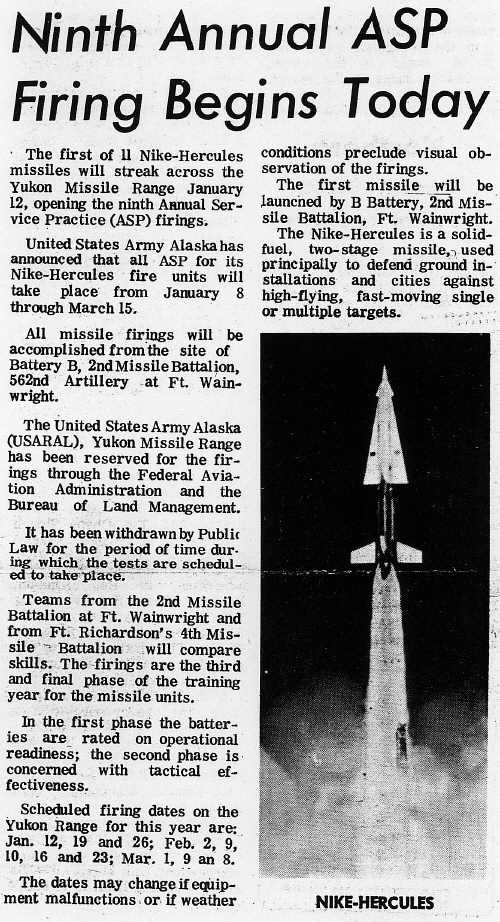
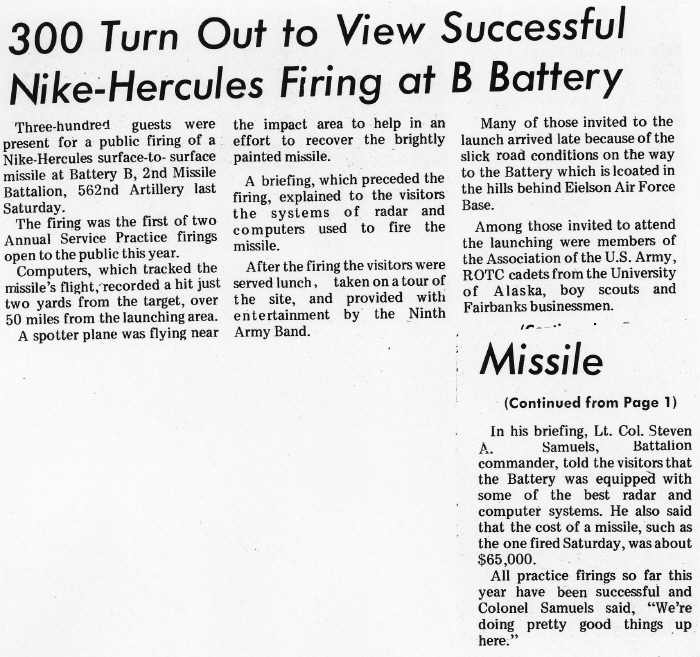
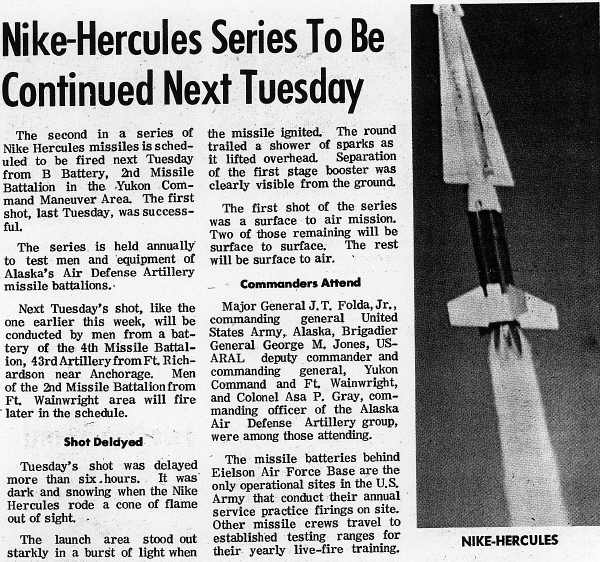
Naturally, guests were not the only ones fascinated to watch these beautiful missiles fly. Anyone not on duty or otherwise occupied at the time was of course free to watch from ringside seats.
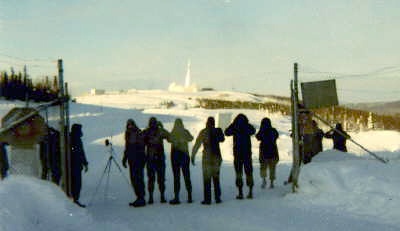
And capture images of course...
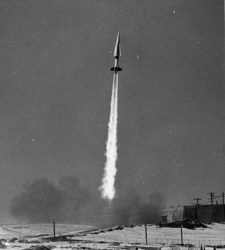
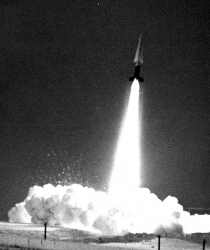
Night launches must have been beyond "spectacular".
Naturally, everyone from the highest brass on down to the most junior of enlisted men took great interest in the performance of each battery at these events and it was considered a high honor to achieve the highest score. Below is the "performace board" on the wall at B battery.
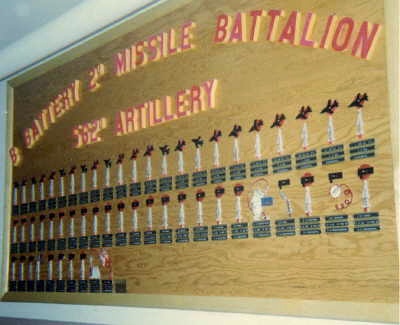
As an aside, one of the responsibilities of every on-duty Nike crew was to keep the tile floors of their facilites waxed and buffed to a high sheen. This was a daily and nightly duty and any Nike vet can attest to the many lonely hours spent in the middle of the night running the electric buffer back and forth across that tile. This never-ending task and fact of Nike life inspired the pencil and charcoal rendition of the Expert Rifleman Badge reproduced below. It was created by a soldier of B-2-562 circa 1968.
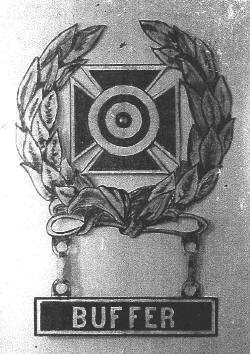
The artist notes: "That drawing was originally done as part of a short timer's calendar for one of the guys that left before me. Later it was taped to the door of the latrine. We photographed it, shrunk it down to the size of a real medal and all wore them one day for an inspection. Luckily they saw the humor and no one got in trouble.... I guess I drew fifty or sixty short timer calendars before I got mine. Most were a cartoon of a guy relieviing himself on whatever piece of equipment he worked on. Several guys wanted the buffer in their calendar, so I guess that's where the idea was born."
Beside the occasional missile firing, card games, beer, and Volleyball were not the only chances for entertainment at site Peter. Like all Alaska Nike sites, the opportunities for hiking, hunting, and fishing were without parallel. In winter, the Eielson AFB ski lodge was about 20 miles down B-battery's road:
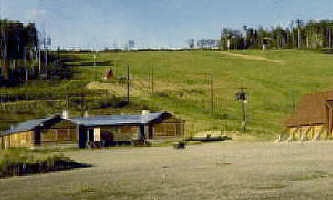
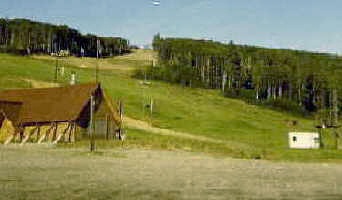
Expended Nike boosters from ASP launches found in the countryside could provide handy targets for shooting practice too. There wasn't much left of a first stage after a fall from 100,000 feet or more.
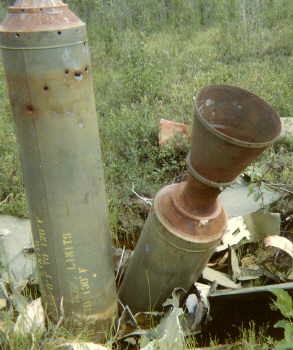
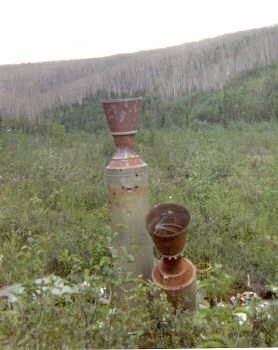
In the face of budgetary constraints imposed by the protracted Vietnam war, the changeing Soviet threat, and therefore changes in the defensive requirements of NORAD, the 2nd Missile Battallion, 562nd Artillery which occupied these sites surrounding Fairbanks was deactivated in 1970. The Nike sites in the Anchorage area continued operations until 1979, but since that time no active Nike-Hercules missile men have walked the halls of these decaying facilites.

Here is a photo of the TTR tower taken in 1993. The ravages of time and vandalizm have taken their toll.

You can view further pictures taken in 1993 of sites Peter and/or Mike by CLICKING HERE.
A search of online aerial photographs turned up the two photos below which I believe were taken in 1996. The image on the left is of a portion of what I believe to be the launcher area about 1 mile north of the IFC, and the image on the right is obviously the remains of a Nike IFC area. Three clamshell-type antenna towers are clearly visible, indicating that the site was Improved Hercules capable. It appears that the main building is only a foundation though.The base of the large aquisition radar dome is the large square structure at lower left of the main IFC building.
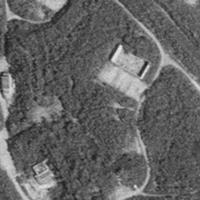
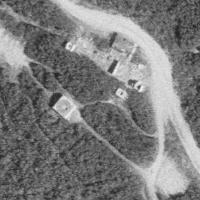
This next photograph below was supplied to me by a young U.S.Army air defender that used the place for a Stinger air defense position during exercises with the Air Force in about 2001 and appears to be taken from the remains of the acquisition radar building.
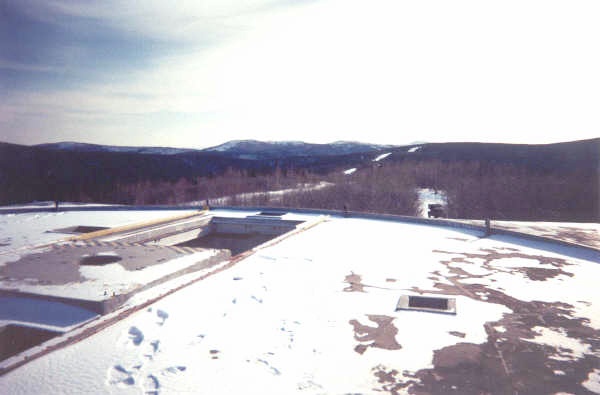
- Juliet Tango Sierra
January, 2005
